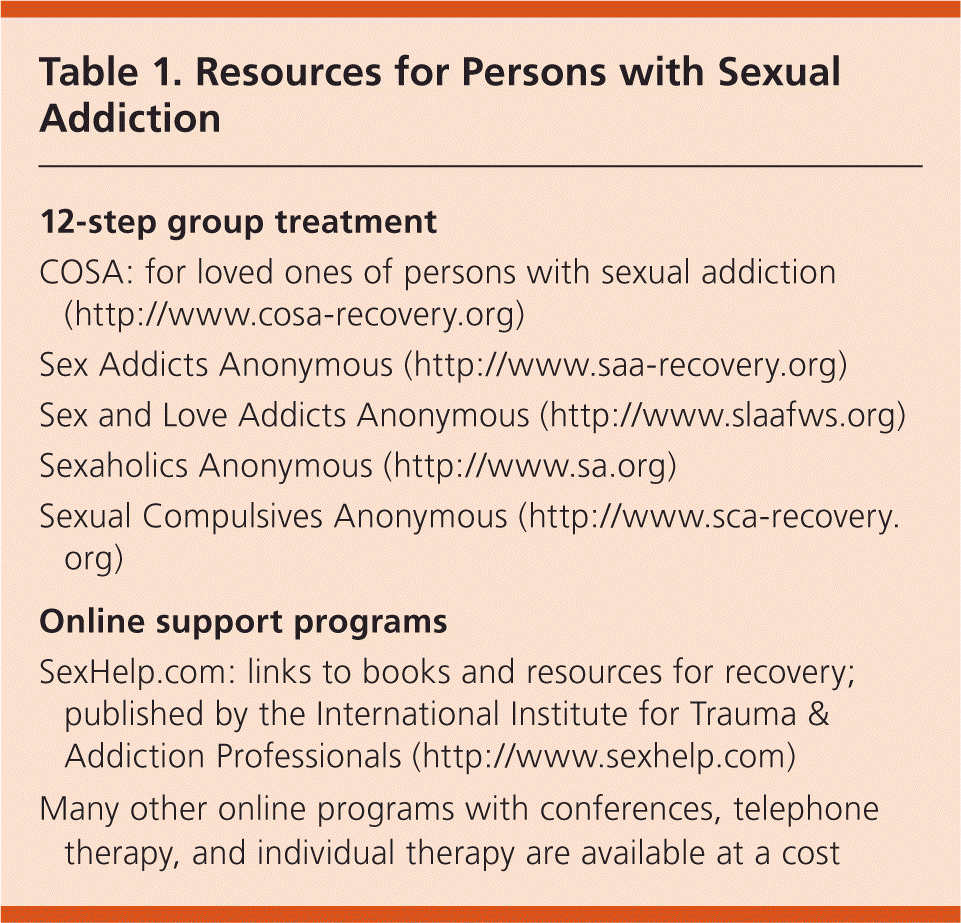
Am Fam Physician. 2012;86(1):74-76
Author disclosure: No relevant financial affiliations to disclose.
Case Scenario
A 46-year-old man with no previous medical problems presents with depressed mood and difficulty initiating sleep. After further review, I discover that the patient recently separated from his wife and fears losing his job. He reluctantly mentions that the problems started when his wife became aware of several years of escalating use of Internet pornography and explicit online chat rooms. He also was caught viewing pornography on work computers, in spite of being previously warned to stop. Measures to control his use, including Internet monitoring programs, failed to limit his behavior. He denies problems with alcohol and any other sexual compulsivity, except masturbation when he views pornography. He is embarrassed, but feels desperate to do whatever it takes to repair his marriage and keep his job. He seems motivated to change, and I want to help him before his problems escalate further. What is the best way to treat his addiction?
Commentary
This patient’s behavior is concerning because of ongoing compulsive behavior despite significant repercussions in his home and work life. Sexual addiction has been described as a behavioral addiction (similar to gambling), a compulsive disorder (similar to obsessive-compulsive disorder), and an impulse control disorder.1 The only behavioral addiction listed in the Diagnostic and Statistical Manual of Mental Disorders, 4th ed. (DSM-IV) is gambling addiction, although it may be practical to define compulsive and maladaptive sexual behavior as an addictive disorder.2 Sexual addiction includes a spectrum of dysfunction, from inability to control the use of pornography to acting out sexually through different paraphilias (e.g., pedophilia, fetishism, exhibitionism).3 So-called sexual addiction constitutes a growing national concern, with an estimated 3 to 6 percent of adults affected, although it is difficult to reliably describe the prevalence.3 Internet filtering research suggests that 10 percent of men in the United States admit to Internet sexual addiction.4
EVALUATION
Primary care physicians should consider sexual addiction a potential problem in patients with symptoms of mood disorders or other psychosocial disorders. The most common screening tool for sexual addiction is the 45-question Sexual Addiction Screening Test (SAST-R),5 although a shorter screening test known as PATHOS was recently validated.6 Diagnosis using the DSM-IV criteria for substance addiction, as applied to sexual behavior, should be intuitive to family physicians. They should assess the severity of the addiction by asking the patient about frequency and type of behavioral problems, legal issues, family and relationship difficulty, and likelihood of rapid progression.7 Screening for concurrent disorders should occur at the time of presentation, because mood disorders and other addictions are common, especially drug and alcohol abuse.2
Medical comorbidity, although less common than psychiatric comorbidity, should also be assessed. Embarrassment or fear of receiving a sexually transmitted infection diagnosis may prevent the patient from divulging risk-taking behavior. Accordingly, the physician should attempt to elicit a thorough sexual history. Physicians should evaluate patients with a history of anonymous sexual interactions for evidence of trauma and sexually transmitted infections.
TREATMENT
Treatment of sexual addiction is an ongoing field of study with several promising options, although few controlled trials exist to provide evidence-based recommendations. Most patients benefit from outpatient treatment, although when legal problems become the cause for evaluation, the physician may consider specialized residential treatment.
Like other behavioral disorders, appropriate treatment of sexual addiction includes psychological and pharmacologic modalities. Cognitive behavioral therapy provides patients with structured environments to better understand and manage their compulsive behavior. Cognitive behavioral therapy has been studied in Internet-mediated sexual addiction, with clinically significant improvement.8 Several organizations offer group-based treatments (Table 1), by telephone or in person, that are largely based on the 12-step process of Alcoholics Anonymous. No prospective trials have been conducted to evaluate group meetings, although their benefit in providing accountability and positive relationships, improving treatment compliance, and preventing relapse has been described.9 Free online treatment options exist for more anonymous treatment (Table 1).

| 12-step group treatment |
| COSA: for loved ones of persons with sexual addiction (http://www.cosa-recovery.org) |
| Sex Addicts Anonymous (http://www.saa-recovery.org) |
| Sex and Love Addicts Anonymous (http://www.slaafws.org) |
| Sexaholics Anonymous (http://www.sa.org) |
| Sexual Compulsives Anonymous (http://www.sca-recovery.org) |
| Online support programs |
| SexHelp.com: links to books and resources for recovery; published by the International Institute for Trauma & Addiction Professionals (http://www.sexhelp.com) |
| Many other online programs with conferences, telephone therapy, and individual therapy are available at a cost |
Pharmacologic treatments also have limited supporting evidence. Several case studies and one small randomized trial show benefit with selective serotonin reuptake inhibitors (SSRIs).2,10 Case reports on various other approaches, including naltrexone (Vivitrol)11 and topiramate (Topamax),12 show promise, although further research is needed before their use for sexual addiction becomes commonplace. Pharmacologic therapy should function as an adjunct to behavioral interventions; it can be considered early in the recovery process to moderate compulsivity, especially for compulsions that threaten the patient’s safety or livelihood. Titration of an SSRI may also be considered in the presence of comorbid mood disorders.
CASE RESOLUTION
The physician in this case should focus on establishing a therapeutic alliance with the patient in which honesty and trust are encouraged, with a treatment plan and follow-up care based on other care coordination needs. Helping the patient seek accountability with someone he trusts provides a good first step in the patient recognizing his problems. Consideration can be given to SSRI treatment, primarily to augment behavioral interventions. Behavioral therapy should be started with a therapist, a community-based support group, or pastoral care, when appropriate to the individual patient.
